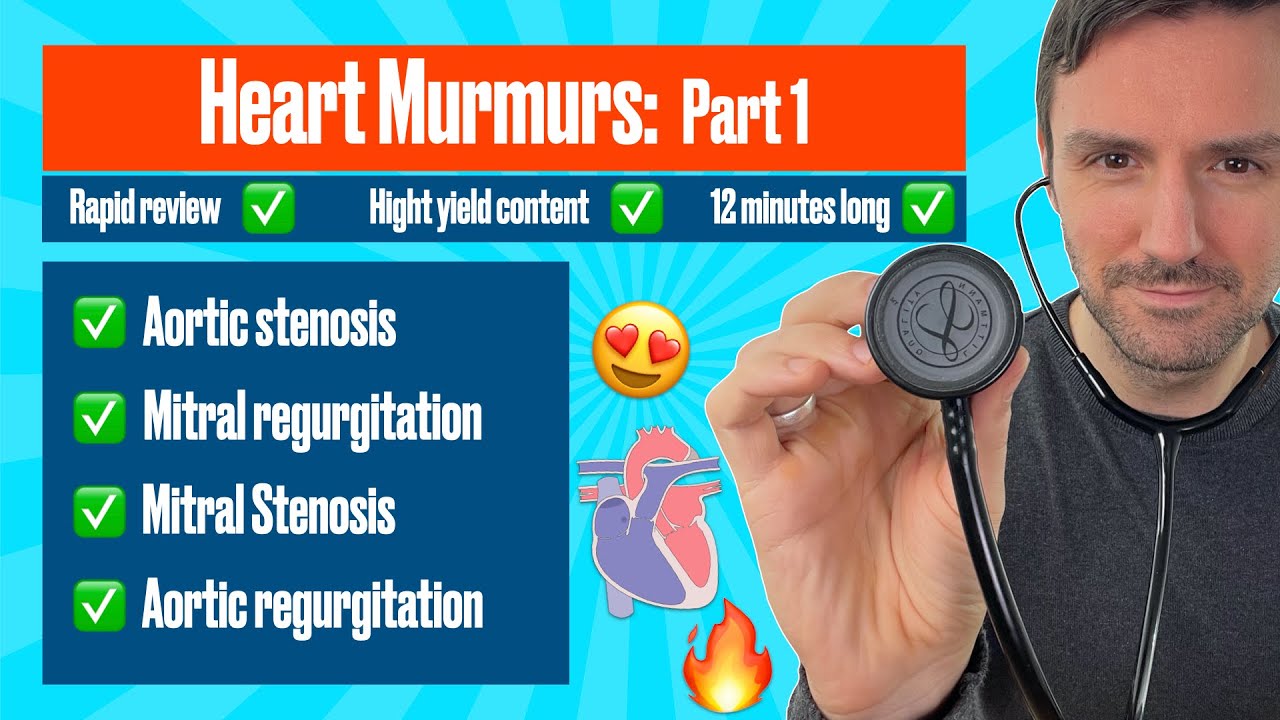Heart Sounds and Heart Murmurs, Animation.
Summary
TLDRThis video script explains the mechanics of heart sounds and murmurs. It breaks down the 'lub-dub' sounds, detailing the events during systole and diastole phases. The script highlights how heart murmurs are caused by turbulent blood flow and describes their timing, intensity, and location on the chest. It covers common conditions like mitral and tricuspid valve regurgitation, aortic stenosis, and pulmonary stenosis, explaining their respective murmurs. The video also delves into diastolic murmurs, such as aortic valve regurgitation, and other conditions, offering a comprehensive look at heart sounds and their diagnostic significance.
Takeaways
- 😀 A healthy heart produces two distinct sounds, 'lub' (S1) and 'dub' (S2), corresponding to the closing of specific heart valves.
- 😀 S1 (lub) occurs when the atrioventricular (AV) valves close after the atria pump blood into the ventricles.
- 😀 S2 (dub) is caused by the closing of the aortic and pulmonary valves after the ventricles eject blood.
- 😀 The time between S1 and S2 is called systole, during which the ventricles contract.
- 😀 The time between S2 and the next S1 is diastole, when the ventricles relax and fill with blood.
- 😀 Diastole is longer than systole, creating the characteristic rhythm of 'lub-dub'.
- 😀 Heart sounds can be auscultated at four main sites: aortic, pulmonic, tricuspid, and mitral valve areas.
- 😀 Heart murmurs are caused by turbulent blood flow and are diagnosed based on their timing, intensity, and the site where they are heard.
- 😀 Systolic murmurs can indicate conditions such as mitral valve regurgitation, tricuspid valve regurgitation, and aortic stenosis.
- 😀 Diastolic murmurs are associated with conditions like aortic valve regurgitation and pulmonic regurgitation.
- 😀 Murmurs can be detected by their specific characteristics, such as crescendo-decrescendo shapes in aortic stenosis or holosystolic patterns in mitral regurgitation.
Q & A
What causes the first heart sound (S1), or 'lub'?
-The first heart sound (S1), or 'lub', is caused by the closing of the atrioventricular (AV) valves after the atria have pumped blood into the ventricles.
What is the second heart sound (S2), or 'dub', caused by?
-The second heart sound (S2), or 'dub', is caused by the closing of the aortic and pulmonary valves after the ventricles have ejected blood.
What happens during systole in the cardiac cycle?
-During systole, the ventricles contract and pump blood out of the heart. This phase occurs between S1 and S2.
How does diastole differ from systole?
-Diastole is the phase when the ventricles relax and fill with blood. It occurs between S2 and the next S1 and is longer than systole.
Where are heart sounds typically auscultated, and why is this important?
-Heart sounds are auscultated at four different sites on the chest wall, corresponding to the location of the heart valves (aortic, pulmonic, tricuspid, and mitral). This helps differentiate defects associated with different valves.
What is the significance of heart murmurs, and what do they indicate?
-Heart murmurs are abnormal, whooshing sounds caused by turbulent blood flow. They indicate possible underlying heart valve issues, such as regurgitation or stenosis.
How are systolic murmurs characterized, and what are some common causes?
-Systolic murmurs occur during ventricular contraction. Common causes include mitral valve regurgitation, tricuspid regurgitation, aortic valve stenosis, and pulmonic stenosis.
What is the typical sound and characteristics of a mitral valve regurgitation murmur?
-A mitral valve regurgitation murmur is holosystolic (occurs throughout systole), best heard at the apex, and may radiate to the left axilla. It is caused by incomplete closure of the mitral valve, resulting in backflow of blood into the left atrium.
How can aortic valve stenosis be identified by its murmur?
-Aortic valve stenosis creates a crescendo-decrescendo murmur, starting shortly after S1, peaking at mid-systole, and decreasing towards the end of systole. It is often preceded by an ejection click and is best heard in the aortic area, radiating to the carotid arteries.
What is the difference between a systolic murmur and a diastolic murmur?
-Systolic murmurs occur during ventricular contraction (between S1 and S2), while diastolic murmurs occur during ventricular relaxation (between S2 and the next S1). Diastolic murmurs are associated with conditions like aortic regurgitation and pulmonic regurgitation.
Outlines

هذا القسم متوفر فقط للمشتركين. يرجى الترقية للوصول إلى هذه الميزة.
قم بالترقية الآنMindmap

هذا القسم متوفر فقط للمشتركين. يرجى الترقية للوصول إلى هذه الميزة.
قم بالترقية الآنKeywords

هذا القسم متوفر فقط للمشتركين. يرجى الترقية للوصول إلى هذه الميزة.
قم بالترقية الآنHighlights

هذا القسم متوفر فقط للمشتركين. يرجى الترقية للوصول إلى هذه الميزة.
قم بالترقية الآنTranscripts

هذا القسم متوفر فقط للمشتركين. يرجى الترقية للوصول إلى هذه الميزة.
قم بالترقية الآنتصفح المزيد من مقاطع الفيديو ذات الصلة

Heart Murmurs and Heart Sounds: Visual Explanation for Students

MENDENGARKAN SUARA JANTUNG: S1, S2, S3, S4, MURMUR

Auscultation of Heart Sounds | Assessing Heart Sounds | Listening to the Heart with a Stethoscope

EKG and Heart Murmur Review - Part 2

VET Talks- Cardiac Auscultation and Heart Murmurs

Heart murmurs for beginners 🔥 🔥 🔥 Part 1:Aortic & Mitral stenosis, Aortic & mitral regurgitation.
5.0 / 5 (0 votes)
